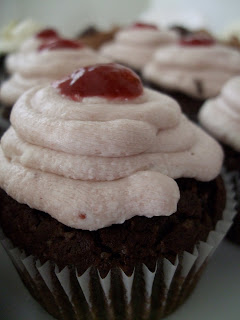
I accidentally had a cupcake for lunch on Valentine's Day; it wasn't planned, it just was there in front of me at noon, and I thought "I can't just Not Eat that cupcake." So I ate it. Which reminded me that I made all of these cupcakes last weekend for a friend's birthday...


She had requested a variety of frostings - chocolate, cream cheese, and vanilla bean - so I decided go on a spurt of cupcake creativity. The kind of spurt where I make 6 different flavors, using a basic cake and frosting as a foundation. I honestly started out with about 10 flavors in mind, which I whittled down to 6, which finally became 5 in the absence of key ingredients and extra time.
This time I went with my favorite mascarpone chocolate cupcake recipe, minus the mixed-in chocolate chips. For one of the flavors I mixed in some spice, and for one I added some white chocolate chips, but the rest I left plain chocolate. And then came the icings:
To make this into a chocolate buttercream, add:
1 T unsweetened cocoa powder
4 oz melted dark chocolate (bittersweet chocolate chips work fine)
To make this into a cinnamon chocolate icing (think Mexican chocolate, with cinnamon mixed into the batter as well!) add:
1 tsp ground cinnamon
Mascarpone White Chocolate Frosting
For the remaining cupcakes, I made a mascarpone icing, similar to cream cheese but a little less sour. Together with the chocolate cupcakes that had white chocolate chips mixed in, it had the effect of a chocolate cheesecake. I split off some of this frosting to also make a raspberry mascarpone icing, for which I filled the chocolate cupcakes with raspberry jam. To fill cupcakes, cut a cone out of the top of the cupcake, into the middle of the cake, and then lop off the tip of the cone, fill the space with jam, and replace the top of the cake.
Cream together:
1/4 C (1/2 stick) salted butter
1/4 C mascarpone cheese
1 tsp vanilla
Then add:
2 C powdered sugar
3 oz. melted white chocolate chips
To make this a raspberry mascarpone white chocolate icing (shall we just call this "raspberry" for short?), add:
several tablespoons of good raspberry jam (to taste)
When making these frostings, cream the butter/mascarpone and vanilla well together first, until it's getting fluffy, and then after slowly encorporating the powdered sugar and other additions, beat it long enough to make it light and smooth. You want it to make voluptuous cupcakes, n'est-ce pas?
It's always my feeling that food should be decorated to look like it tastes, so I encourage you to find creative ways of doing so - while it might seem too obvious to put white chocolate chips on top of white chocolate frosting, I like the way the textures and shapes look together. And hey, you know what you're eating when you pick it up.
Be forewarned that the amounts of icing produced by these recipes are not proportionate to one batch of 24 cupcakes; the vanilla bean buttercream is more than enough to frost 24, but the mascarpone icing is about enough for 12.
Bon appétit!













